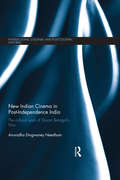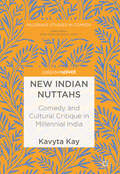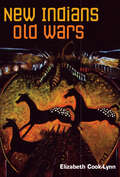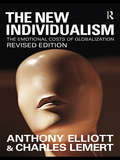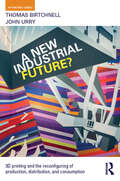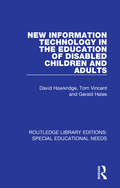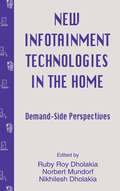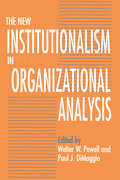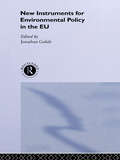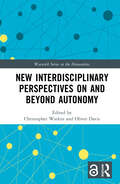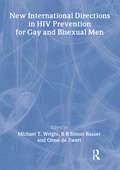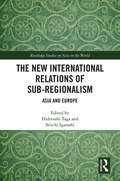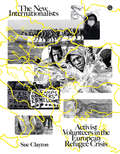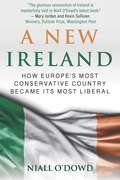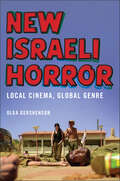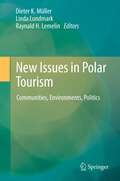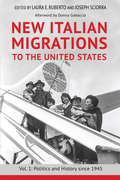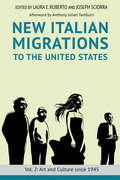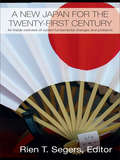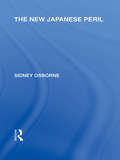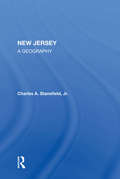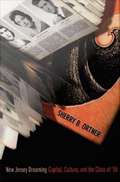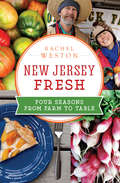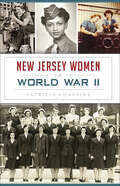- Table View
- List View
New Indian Cinema in Post-Independence India: The Cultural Work of Shyam Benegal’s Films (Intersections: Colonial and Postcolonial Histories)
by Anuradha Dingwaney NeedhamShyam Benegal is an Indian director and screenwriter whose work is considered central to New Indian cinema. By closely analysing several of Benegal’s films, this book provides an understanding of India’s post-independence history. The book examines the filmmaker’s focus on women by highlighting his subtle and critical engagement with a truism of Indian nationalism: women’s centrality to the (nation-) state’s negotiation with modernity. It looks at the importance Benegal accords to history – its little known, contested, or iconic events and figures – in crafting national culture and identities, and goes on to discuss the filmmaker’s nuanced representation of the developmental agendas of the nation-state. The book presents an account of the relationship of historical film and fiction to official history, and provides a fuller understanding of Indian cinema, and how it is shaped by as well as itself shapes national imperatives. Filling a gap in the literature, the book offers an analysis of cinematic treatment of post-independence narratives and gives important insights into the imagination of the time. It is a useful contribution for students and scholars of Film Studies, South Asian History and South Asian Culture.
New Indian Nuttahs: Comedy and Cultural Critique in Millennial India (Palgrave Studies in Comedy)
by Kavyta KayThis book takes a journey into the new and exciting created by a the wave of Indian comedians today, described affectionately here as the New Indian Nuttahs, and looks at what these tell us about identity, “Indianness”, censorship, feminism, diaspora and millennial India. It provides a unique analysis into the growing phenomenon of internet comedy and into a dimension of Indian popular culture which has long been dominated by the traditional film and television industries. Through a mixture of close textual readings of online comedy videos and interviews with content creators and consumers in India, this book provides a fresh perspective on comedy studies in its approach to a global South context from a sociocultural perspective. As a protean form of new media, this has opened up new avenues of articulation, identification and disidentification and as such, this book makes a further contribution to South Asian, communication, media & cultural studies.
New Indians, Old Wars
by Elizabeth Cook-LynnChallenging received American history and forging a new path for Native American studies Addressing Native American Studies' past, present, and future, the essays in New Indians, Old Wars tackle the discipline head-on, presenting a radical revision of the popular view of the American West in the process. Instead of luxuriating in its past glories or accepting the widespread historians' view of the West as a shared place, Elizabeth Cook-Lynn argues that it should be fundamentally understood as stolen. Firmly grounded in the reality of a painful past, Cook-Lynn understands the story of the American West as teaching the political language of land theft and tyranny. She argues that to remedy this situation, Native American studies must be considered and pursued as its own discipline, rather than as a subset of history or anthropology. She makes an impassioned claim that such a shift, not merely an institutional or theoretical change, could allow Native American studies to play an important role in defending the sovereignty of indigenous nations today.
The New Individualism: The Emotional Costs of Globalization REVISED EDITION
by Anthony Elliott Prof Charles LemertThis is a new and revised edition of a book which has had a major impact upon the social sciences and public political debate. Anthony Elliott and Charles Lemert's THE NEW INDIVIDUALISM inspired readers with the dramatic suggestion that 'the reinvention craze' - from self-help and therapy culture to management restructurings and corporate downsizings - is central to a 'new individualism' sweeping the globe. Giving particular attention to the narratives of people seeking to define anew their lives in an age of globalization, the authors contend that an endless hunger for instant change and relentless emphasis on self-reinvention is fundamental to grasping the disorientating effects of the new individualism. This edition contains a substantial new Introduction in which Elliott and Lemert reply to some of the standard criticisms made of the theory of the new individualism, and also addresses the escalation of new individualist thinking in the wake of recent global crises.
A New Industrial Future?: 3D Printing and the Reconfiguring of Production, Distribution, and Consumption (Antinomies)
by John Urry Thomas BirtchnellA New Industrial Future? examines whether a further industrial revolution is taking place around the world. In this compelling book Birtchnell and Urry examine such a new possible future involving the mass adoption of 3D printing. The locating of 3D printers in homes, offices, stores and workshops would disrupt existing systems and pose novel challenges for incumbents. The book drawing upon expert interviews, scenario workshops and various case studies assesses the potential future of global manufacturing, freight transport, world trade and land use. It offers the first book-length social scientific analysis of the character and impacts of a new system of manufacturing that is in formation. The book will be of interest to urban planners, policy makers, social scientists, futurologists, economists, as well as general readers by offering inquiry on this future upheaval in the means of production.
New Information Technology in the Education of Disabled Children and Adults (Routledge Library Editions: Special Educational Needs #32)
by David Hawkridge Tom Vincent Gerald HalesFirst published in 1985. Information technology can offer huge benefits to the disabled. It can help many disabled people to overcome barriers of time and space and to a much greater extent it can help them to overcome barriers of communication. In that way new information technology offers opportunities to neutralise the worst effects of many kinds of disablement. This book reviews the possibilities of using information technology in the education of the disabled. Commencing with an assessment of the learning problems faced by disabled people, it goes on to look at the scope of information technology and how it has been used for the education of students of all ages, particularly in the United Kingdom and the United States. A penultimate section considers most of the contentious issues that faced users of technology, whilst the conclusion devotes itself to the immediate and longer-term future, suggesting possible future trends and the consequent problems that may arise.
New infotainment Technologies in the Home: Demand-side Perspectives (Routledge Communication Series)
by Ruby Roy Dholakia Norbert Mundorf Nikhilesh DholakiaAs the "information superhighway" moves into the home through interactive media, enhanced telecom services, and hybrid appliances, interest continually grows in how consumers adopt and use Information Technology (IT), the strategies IT marketers use to reach consumers, and the public policies that help and protect consumers. USE COPY FROM THIS POINT ON FOR GENERAL CATALOGS... This book presents a unique collection of papers dealing with the demand side issues of new information technologies in the home. The contributors are from business, academia, and the public policy sector and represent many disciplines including communication, marketing, economics, psychology, engineering, and information systems. This book provides one of the best introductions to complex issues such as: * business forces that will shape "Home IT" of the future; * industry structure of the future "Infotainment" mega-business; * factors affecting consumer adoption and use of IT; * international differences in the management of the IT sector; and * public policies that will shape the deployment and use of IT.
The New Institutionalism in Organizational Analysis
by Edited by Walter W. Powell Paul J. DimaggioLong a fruitful area of scrutiny for students of organizations, the study of institutions is undergoing a renaissance in contemporary social science. This volume offers, for the first time, both often-cited foundation works and the latest writings of scholars associated with the "institutional" approach to organization analysis. In their introduction, the editors discuss points of convergence and disagreement with institutionally oriented research in economics and political science, and locate the "institutional" approach in relation to major developments in contemporary sociological theory. Several chapters consolidate the theoretical advances of the past decade, identify and clarify the paradigm's key ambiguities, and push the theoretical agenda in novel ways by developing sophisticated arguments about the linkage between institutional patterns and forms of social structure. The empirical studies that follow-involving such diverse topics as mental health clinics, art museums, large corporations, civil-service systems, and national polities-illustrate the explanatory power of institutional theory in the analysis of organizational change. Required reading for anyone interested in the sociology of organizations, the volume should appeal to scholars concerned with culture, political institutions, and social change.
The New Institutionalism in Organizational Analysis
by Walter W. Powell Paul J. DiMaggioLong a fruitful area of scrutiny for students of organizations, the study of institutions is undergoing a renaissance in contemporary social science. This volume offers, for the first time, both often-cited foundation works and the latest writings of scholars associated with the "institutional" approach to organization analysis. In their introduction, the editors discuss points of convergence and disagreement with institutionally oriented research in economics and political science, and locate the "institutional" approach in relation to major developments in contemporary sociological theory. Several chapters consolidate the theoretical advances of the past decade, identify and clarify the paradigm's key ambiguities, and push the theoretical agenda in novel ways by developing sophisticated arguments about the linkage between institutional patterns and forms of social structure. The empirical studies that follow—involving such diverse topics as mental health clinics, art museums, large corporations, civil-service systems, and national polities—illustrate the explanatory power of institutional theory in the analysis of organizational change. Required reading for anyone interested in the sociology of organizations, the volume should appeal to scholars concerned with culture, political institutions, and social change.
New Instruments for Environmental Policy in the EU (Routledge/eui Studies In Environmental Policy Ser.)
by Jonathan GolubNew Instruments for Environmental Policy in the EU provides a comprehensive analysis of the debate over new forms of environmental regulation in the European Union.The conclusions draw attention to critical aspects of instrument design, as well as the difficulty of accommodating national policy diversity without contravening EU and international tr
New Interdisciplinary Perspectives On and Beyond Autonomy (Warwick Series in the Humanities)
by Christopher Watkin Oliver DavisWhat does ‘autonomy’ mean today? Is the Enlightenment understanding of autonomy still relevant for contemporary challenges? How have the limits and possibilities of autonomy been transformed by recent developments in artificial intelligence and big data, political pressures, intersecting oppressions and the climate emergency? The challenges to autonomy today reach across society with unprecedented complexity, and in this book leading scholars from philosophy, economics, linguistics, literature and politics examine the role of autonomy in key areas of contemporary life, forcefully defending a range of different views about the nature and extent of resistance to autonomy today. These essays are essential reading for anyone who wants to understand the predicament and prospects of one of modernity’s foundational concepts and one of our most widely cherished values. Chapter 5.6 and 9 of this book is freely available as a downloadable Open Access PDF at http://www.taylorfrancis.com under a Creative Commons [Attribution-Non Commercial-No Derivatives (CC-BY-NC-ND)] 4.0 license.
New International Directions in HIV Prevention for Gay and Bisexual Men
by Michael Wright B R RosserIt is widely recognized that current HIV intervention models are falling short of their goals. What are the alternatives?To answer this question, New International Directions in HIV Prevention for Gay and Bisexual Men presents a collection of articles from European and American authors that rival dominant paradigms of HIV prevention. Researchers, practitioners, and community organizations will be challenged to examine current assumptions and to consider neglected aspects of risk behavior such as love, trust, and the dynamics of sexual intimacy. New International Directions in HIV Prevention for Gay and Bisexual Men explores models and theories that will help you develop more effective HIV prevention programs to better serve patients and clients.New International Directions in HIV Prevention for Gay and Bisexual Men offers you fresh perspectives on prevention work by examining risk behaviors in the interactional, communal, and social contexts in which they are practiced. You will receive alternative explanations and reasons for HIV risk that go beyond current approaches and that introduce possibilities for new intervention strategies. Written by experts in the field, the chapters in New International Directions in HIV Prevention for Gay and Bisexual Men will give you insight into new ideas and developments, including: placing a greater emphasis on improving successful risk management strategies as opposed to quantifying risk factors examining the meaning and context of sexual acts which occur in casual encounters or steady partnerships and incorporating their relevancy into prevention work considering the effects that cultural context and socially constructed meanings have on prevention work and incorporating individuals’values and feelings into prevention strategies focusing on more realistic goals of harm reduction that take sexual decision making into consideration as opposed to expecting abstinence relating the various aspects of sexual encounters--physical attraction, intimacy, reciprocity, and power--to reasons why men choose not to use condomsExamining how gay men can underestimate the risk of HIV in order to meet needs of intimacy, New International Directions in HIV Prevention for Gay and Bisexual Men will help you understand the symbolic dimension of sexual contact. The normal, everyday reasons for having sex without a condom are explored, questioning models which often characterize unprotected sex as being the result of low self-esteem, substance abuse, or some other psychological vulnerability. Presenting data from both qualitative and quantitative research conducted at group and individual levels, this book reveals the complexity of risk behavior, the richness of sexual experience, and the importance of respecting the unique context in which gay men live their sexual lives. New International Directions in HIV Prevention for Gay and Bisexual Men will help you understand this point of view, enabling you to provide patients and clients with more effective HIV prevention and risk management services.
The New International Relations of Sub-Regionalism: Asia and Europe (Routledge Studies on Asia in the World)
by Hidetoshi Taga Seiichi IgarashiIn the context of the end of the Cold War and the spread of globalism, sub-regions are attracting attention as new social units of international society never before observed. In the "second wave" of regionalism that became active in the 1980s, a new regionalism, which differed qualitatively from the old regionalism, expanded globally. This "new regionalism" is characterized by multi-dimensionality, complexity, fluidity, and non-conformity, and within it we cannot overlook the fact that spaces on a new scale, such as sub-regions, are being formed in various parts of the world. The sovereign state system that has continued unbroken since the Westphalia Treaty is being transformed, and within this context, the increase in the number of sub-regions as new social units adds to the sense that we have arrived at a post-Westphalian international order. This book focuses on sub-region as a new social unit of international society. It is based on the findings obtained through meticulous fieldwork and joint studies conducted over the past 10 years by about 20 researchers, primarily from Japanese universities and Chiang Mai University, Thailand. The sub-regions described here are mostly international cross-border spaces or units in the interior of a certain region, which include: multiple states, states and parts of states, or more than two parts of states (often referred to as micro-regions). Such sub-regions have been formed in various parts of the world since the end of the Cold War. However, studies on sub-regions remain unexplored in the existing studies of regionalism. The few studies that do exist mainly focus on the economic aspects of sub-regions. In contrast, this book will specifically examine the sub-regions in Asia (especially the Mekong region and Europe) as main cases from a political science and international relations perspective, aiming to establish a new/alternative international relations by carving out a political angle of sub-region as a new social unit of international society and attempting to shift the paradigm of conventional international relations. To understand the political dimension of a sub-region, this book will mainly focus on three aspects: sub-regions and state strategies, bottom-up dimension of sub-regions, and sub-regions and borders.
The New Internationalists: Activist Volunteers in the European Refugee Crisis
by Sue ClaytonAn account of the mobilization of thousands of volunteers who rescued, supported, and welcomed refugees during the recent European refugee crisis.In The New Internationalists, Sue Clayton tells the story of the largest civic mobilization since the Second World War, when volunteers--many young and untrained--took on unimaginable responsibilities and saved thousands of lives. During the European refugee crisis of 2015-2020, they witnessed first hand the catastrophic failure of established NGOs, and the indifference--and frequently, the open hostility--of the EU and national governments. Many faced state hostility themselves. Their accounts show how activist volunteers have shaped today's European humanitarian agenda, and provide a powerful critique of failures of current policy.
A New Ireland: How Europe's Most Conservative Country Became Its Most Liberal
by Niall O'DowdIn a May 2019 countrywide referendum, Ireland voted overwhelmingly to make abortion legal; three years earlier, it had done the same with same-sex marriage, becoming the only country in the world to pass such a law by universal suffrage. Pope Francis’s visit to the country saw protests and a fraction of the emphatic welcome that Pope John Paul’s had seen forty years earlier. There have been two female heads of state since 1990, the first two in Ireland’s history. Prime Minister Leo Varadkar, an openly gay man of Indian heritage, declared that “a quiet revolution had taken place.” <p> It had. For nearly all of its modern history, Ireland was Europe’s most conservative country. The Catholic Church was its most powerful institution and held power over all facets of Irish life. <p> But as scandal eroded the Church’s hold on Irish life, a new Ireland has flourished. War in the North has ended. EU membership and an influx of American multinational corporations have helped Ireland weather economic depression and transform into Europe’s headquarters for Apple, Facebook, and Google. <p> With help from prominent Irish and Irish American voices like historian and bestselling author Tim Pat Coogan and the New York Times’s Maureen Dowd, A New Ireland tells the story of a modern revolution against all odds.
New Israeli Horror: Local Cinema, Global Genre
by Olga GershensonBefore 2010, there were no Israeli horror films. Then distinctly Israeli serial killers, zombies, vampires, and ghosts invaded local screens. The next decade saw a blossoming of the genre by young Israeli filmmakers. New Israeli Horror is the first book to tell their story. Through in-depth analysis, engaging storytelling, and interviews with the filmmakers, Olga Gershenson explores their films from inception to reception. She shows how these films challenge traditional representations of Israel and its people, while also appealing to audiences around the world. Gershenson introduces an innovative conceptual framework of adaptation, which explains how filmmakers adapt global genre tropes to local reality. It illuminates the ways in which Israeli horror borrows and diverges from its international models. New Israeli Horror offers an exciting and original contribution to our understanding of both Israeli cinema and the horror genre. A companion website to this book is available at https://blogs.umass.edu/newisraelihorror/ (https://blogs.umass.edu/newisraelihorror/) Book trailer: https://youtu.be/oVJsD0QCORw (https://youtu.be/oVJsD0QCORw)
New Issues in Polar Tourism
by Dieter K. Müller Linda Lundmark Raynald H. LemelinNew Issues in Polar Tourism traces and analyzes a decade of growing interest in the polar regions, and the consequent challenges and opportunities of increasing tourist traffic in formerly remote and seldom-visited places. The book arises from the recently-formed International Polar Tourism Research Network (IPTRN), and documents the outcomes of its 2010 conference, held at Sweden's Abisko Scientific Research Station.
New Italian Migrations to the United States: Politics and History since 1945
by Donna R. Gabaccia Joseph Sciorra Laura E RubertoItalian immigration from 1945 to the present is an American phenomenon too little explored in our histories. Until now. In this new collection, Laura E. Ruberto and Joseph Sciorra edit essays by an elite roster of scholars in Italian American studies. These interdisciplinary works focus on leading edge topics that range from politics of the McCarren-Walter Act and its effects on women to the ways Italian Americans mobilized against immigration restrictions. Other essays unwrap the inner workings of multi-ethnic power brokers in a Queens community, portray the complex transformation of identity in Boston 's North End, and trace the development of Italian American youth culture and how new arrivals fit into it. Finally, Donna Gabaccia pens an afterword on the importance of this seventy-year period in U.S. migration history. Contributors: Ottorino Cappelli, Donna Gabaccia, Stefano Luconi, Maddalena Marinari, James S. Pasto, Rodrigo Praino, Laura E. Ruberto, Joseph Sciorra, Donald Tricarico, and Elizabeth Zanoni.
New Italian Migrations to the United States: Art and Culture since 1945
by Laura E Ruberto Joseph SciorraThis second volume of New Italian Migrations to the United States explores the evolution of art and cultural expressions created by and about Italian immigrants and their descendants since 1945. The essays range from an Italian-language radio program that broadcast intimate messages from family members in Italy to the role of immigrant cookbook writers in crafting a fashionable Italian food culture. Other works look at how exoticized actresses like Sophia Loren and Pier Angeli helped shape a glamorous Italian style out of images of desperate postwar poverty; overlooked forms of brain drain; the connections between countries old and new in the works of Michigan self-taught artist Silvio Barile; and folk revival performer Alessandra Belloni's reinterpretation of tarantella dance and music for Italian American women. In the Afterword, Anthony Julian Tamburri discusses the nomenclature ascribed to Italian American creative writers living in Italy and the United States.
A New Japan for the Twenty-First Century: An Inside Overview of Current Fundamental Changes and Problems (Routledge Contemporary Japan Series)
by Rien T. SegersMany people in the West portray Japan as being fixed in its ways, and unable to change, and consequently risking national decline and international loss of prestige. However, in fact, Japan is at present in a significant transition period, comparable to the Meiji Restoration of 1868 or the period immediately after the Second World War. This transition period comes with a mixture of events and situations which are difficult to interpret both for foreign as well as domestic commentators and decision makers. In this book a range of senior experts from inside Japan outline the many considerable changes currently taking place in a wide range of fields, including the economy, business and technology, politics, governance and international relations, and a wide range of social issues - the media, the position of women, nationalism and national consciousness, and religion. Overall, the book provides a corrective to misplaced Western and Eastern views; it aims to redirect stereotyped thinking about contemporary Japan both inside as well as outside the country. In addition it gives a summary overview of contemporary Japan, its current changes and problems– in short the inside story of the second strongest national economy in the world which is in the process of fundamental re-engineering and which will continue to have a huge impact globally going forward.
The New Japanese Peril (Routledge Library Editions: Japan)
by Sidney OsborneThis volume examines the issues surrounding the renewal of the Anglo-Japanese Treaty of Alliance and looks at the possible consequences of different courses of action, against a backdrop of a Far Eastern situation under constant change. In spite of claims of impartiality, this volume represents widely-held views of the day that "the future supremacy of the white races is endangered" and the author claims to have remained as objective as possible, despite "being a member of the Western family of nations against whom the new Japanese peril may come to be directed."
New Jersey: A Geography (Haunted Ser. #Vol. 8)
by Charles A. StansfieldNew Jersey. The name evokes many images, most of which are narrow stereotypes that fall short of reality. For example, though New Jersey's salient cultural characteristic is its high population density–the highest in the United States and higher than that of Britain–there is a surprising amount of open space in the state. Areas of the pinelands remain virtually unexplored, vast bogs are nearly impenetrable, and lush forests on the Appalachian ridges and holly-decked beaches on the ocean invite the city-weary urbanite. This geographic study of New Jersey, a multidimensional portrait of the state, incorporates three major themes: (1) the state's cultural diversity, an amalgam dating from colonial days, of many varied ethnic, national, and racial groups; (2) its bipolar orientation to two neighboring giant metropolitan areas, New York and Philadelphia, again a factor that dates to the time of the Revolution; and (3) an economy heavily influenced by the state's accessibility to major metropolitan centers and its well-developed corridor functions. Dr. Stansfield depicts New Jersey as a state others should watch: How it controls suburban sprawl, environmental deterioration, and the internal competition among agricultural, suburban, industrial, and recreational uses of land and water resources offers a model for the rest of the United States. Newark's Mayor Gibson observed of his city, "I don't know where America's cities are going, but I think Newark will get there first." It also might be fairly concluded, writes Dr. Stansfield, that wherever the United States is heading, New Jersey could get there first.
New Jersey Dreaming: Capital, Culture, and the Class of '58
by Sherry B. OrtnerPioneering anthropologist Sherry B. Ortner is renowned for her work on the Sherpas of Nepal. Now she turns her attention homeward to examine how social class is lived in the United States and, specifically, within her own peer group. In New Jersey Dreaming, Ortner returns to her Newark roots to present an in-depth look at Weequahic High School's Class of 1958, of which she was a member. She explores her classmates' recollected experiences of the neighborhood and the high school, also written about in the novels of Philip Roth, Weequahic High School's most famous alum. Ortner provides a chronicle of the journey of her classmates from the 1950s into the 1990s, following the movement of a striking number of them from modest working- and middle-class backgrounds into the wealthy upper-middle or professional/managerial class. Ortner tracked down nearly all 304 of her classmates. She interviewed about 100 in person and spoke with most of the rest by phone, recording her classmates' vivid memories of time, place, and identity. Ortner shows how social class affected people's lives in many hidden and unexamined ways. She also demonstrates that the Class of '58's extreme upward mobility must be understood in relation to the major identity movements of the twentieth century--the campaign against anti-Semitism, the Civil Rights movement, and feminism. A multisited study combining field research with an interdisciplinary analytical framework, New Jersey Dreaming is a masterly integration of developments at the vanguard of contemporary anthropology. Engaging excerpts from Ortner's field notes are interspersed throughout the book. Whether recording the difficulties and pleasures of studying one's own peer group, the cultures of driving in different parts of the country, or the contrasting experiences of appointment-making in Los Angeles and New York, they provide a rare glimpse into the actual doing of ethnographic research.
New Jersey Fresh: Four Seasons from Farm to Table (American Palate)
by Rachel WestonNew Jersey's bounty is ripe for the picking. The state boasts thousands of thriving farms, hundreds of CSAs, dozens of community farmers' markets and countless residents dedicated to the locavore lifestyle. Jersey food writer and chef Rachel J. Weston takes a seasonal tour of the state, showcasing the bounty that its down-to-earth farmers, creative artisan producers and innovative chefs produce for their patrons throughout the year. See how globally inspired cuisine representing New Jersey's diverse population is created and adapted using locally sourced products. Savor a juicy August peach, pucker up for a tart cranberry in October and nourish body and soul with local bok choy, asparagus and tomatoes. With local recipes for every season, this book shows why New Jersey is the Garden State.
New Jersey Women in World War II (Military Ser.)
by Patricia ChappineReal-life Rosie the Riveters worked the lines in New Jersey's factories, such as those of General Motors' Eastern Aircraft Division, while women on the vulnerable coast enforced blackout orders. Others sold war bonds, planted victory gardens and conserved materials for the war effort. Thousands more served as nurses and in branches of the armed forces like the Women's Army Corps and the U.S. Navy's Women Accepted for Volunteer Emergency Service. African American women fought a double war--one against the nation's enemies and another against discrimination. Historian Patricia Chappine explores the pivotal roles that New Jersey women played in World War II.
